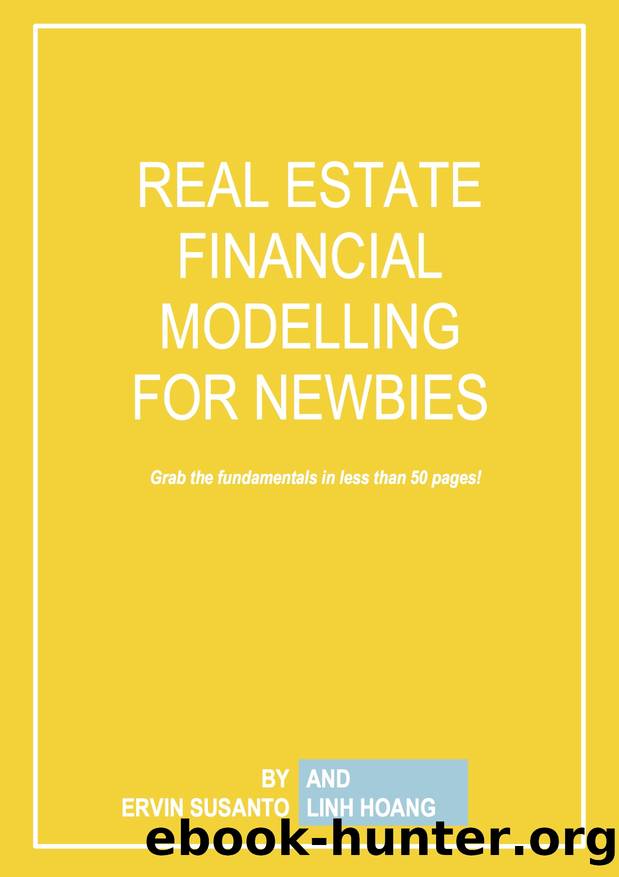Real Estate Financial Modelling for Newbies: Grab the fundamentals in less than 50 pages (Real Estate Investment) by Susanto / Hoang Ervin / Linh

Author:Susanto / Hoang, Ervin / Linh [Susanto / Hoang, Ervin / Linh]
Language: eng
Format: epub
Published: 2018-02-20T00:00:00+00:00
NOI Entry Yield
3.4%
3.0 - 4.0%*
NOI Entry Yield is still within the market range, this justifies the purchase price of our Subject Property
Average NOI Margin
77%
70 - 85%
NOI Margin is still within the market range, this justifies our property income and expenses of our Subject Property
*This refers to the cap rates for office properties in Singapore. Note that unlike rents, property cap rates are not commonly reported in reports. A way to estimate a cap rate will be to gather data on transacted property deals
***
3.5 Corporate Income Tax (CIT)
Income tax will be the last expense to derive Net Income or Operating Cash Flow. Tax rate will differ by countries; e.g. Singapore will be 17% and Malaysia will be 24% (tax rates are easily available online).
Unlevered Operating Cash Flow: Tax = NOI x Tax Rate
Tax will be 0 if NOI is not a positive number
Levered Operating Cash Flow: Tax = (NOI - Financing Expenses) x Tax Rate
Tax will be 0 if (NOI - Financing Expenses) is not a positive number
From this formula, it is understood that debt financing does not only boost returns due to positive leverage but also minimises tax by reducing taxable income. If there are any other expenses below the NOI line, remember to include them to calculate the taxable income (only if they are confirmed to be tax-deductible expenses, have a read on the countryâs tax guides to understand better). These formulas assume that there is no other expense item besides financing costs.
***
3.6 Operating Cash Flow (OCF)
Putting it all together, OCF is calculated using the formulas below, depending on whether leverage is used:
Unlevered Operating Cash Flow (UOCF)
(Revenue - Operating Expenses = NOI) - Tax = UOCF
Levered Operating Cash Flow (LOCF)
(Revenue - Operating Expenses = NOI) - Financing Expenses - Tax = UOCF
Download
This site does not store any files on its server. We only index and link to content provided by other sites. Please contact the content providers to delete copyright contents if any and email us, we'll remove relevant links or contents immediately.
| Analysis & Strategy | Bonds |
| Commodities | Derivatives |
| Futures | Introduction |
| Mutual Funds | Online Trading |
| Options | Portfolio Management |
| Real Estate | Stocks |
Pioneering Portfolio Management by David F. Swensen(5619)
Rich Dad Poor Dad by Robert T. Kiyosaki(5173)
How To Win Friends and Influence People by Dale Carnegie(3791)
The Money Culture by Michael Lewis(3296)
The Dhandho Investor by Mohnish Pabrai(3181)
The Wisdom of Finance by Mihir Desai(3092)
Liar's Poker by Michael Lewis(2823)
The Intelligent Investor by Benjamin Graham Jason Zweig(2604)
The ONE Thing by Gary Keller(2536)
Mastering Bitcoin: Programming the Open Blockchain by Andreas M. Antonopoulos(2525)
Investing For Dummies by Eric Tyson(2480)
How to Day Trade for a Living: Tools, Tactics, Money Management, Discipline and Trading Psychology by Andrew Aziz(2459)
How to Win Friends and Influence People by Dale Carnegie(2453)
Rich Dad Poor Dad: What The Rich Teach Their Kids About Money - That The Poor And Middle Class Do Not! by Robert T. Kiyosaki(2442)
Fooled by Randomness: The Hidden Role of Chance in Life and in the Markets by Nassim Nicholas Taleb(2425)
Zero Hour by Harry S. Dent Jr. & Andrew Pancholi(2255)
Market Wizards by Jack D. Schwager(2172)
Rich Dad's Guide to Investing by Robert T. Kiyosaki(2121)
How to Pay Zero Taxes, 2018 by Jeff A. Schnepper(2110)
